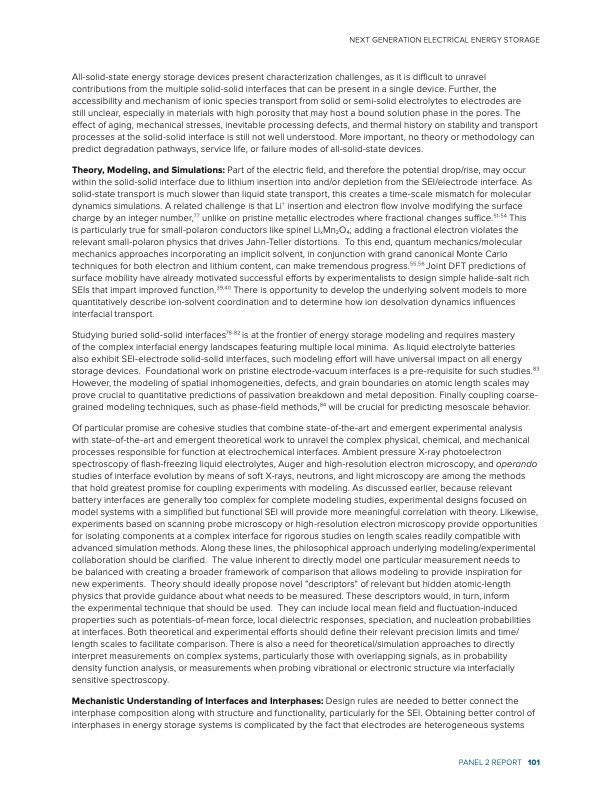
PDF Publication Title:
Text from PDF Page: 107
All-solid-state energy storage devices present characterization challenges, as it is difficult to unravel contributions from the multiple solid-solid interfaces that can be present in a single device. Further, the accessibility and mechanism of ionic species transport from solid or semi-solid electrolytes to electrodes are still unclear, especially in materials with high porosity that may host a bound solution phase in the pores. The effect of aging, mechanical stresses, inevitable processing defects, and thermal history on stability and transport processes at the solid-solid interface is still not well understood. More important, no theory or methodology can predict degradation pathways, service life, or failure modes of all-solid-state devices. Theory, Modeling, and Simulations: Part of the electric field, and therefore the potential drop/rise, may occur within the solid-solid interface due to lithium insertion into and/or depletion from the SEI/electrode interface. As solid-state transport is much slower than liquid state transport, this creates a time-scale mismatch for molecular dynamics simulations. A related challenge is that Li+ insertion and electron flow involve modifying the surface charge by an integer number,77 unlike on pristine metallic electrodes where fractional changes suffice.51-54 This is particularly true for small-polaron conductors like spinel LixMn2O4; adding a fractional electron violates the relevant small-polaron physics that drives Jahn-Teller distortions. To this end, quantum mechanics/molecular mechanics approaches incorporating an implicit solvent, in conjunction with grand canonical Monte Carlo techniques for both electron and lithium content, can make tremendous progress.55,56 Joint DFT predictions of surface mobility have already motivated successful efforts by experimentalists to design simple halide-salt rich SEIs that impart improved function.39,40 There is opportunity to develop the underlying solvent models to more quantitatively describe ion-solvent coordination and to determine how ion desolvation dynamics influences interfacial transport. Studying buried solid-solid interfaces78-82 is at the frontier of energy storage modeling and requires mastery of the complex interfacial energy landscapes featuring multiple local minima. As liquid electrolyte batteries also exhibit SEI-electrode solid-solid interfaces, such modeling effort will have universal impact on all energy storage devices. Foundational work on pristine electrode-vacuum interfaces is a pre-requisite for such studies.83 However, the modeling of spatial inhomogeneities, defects, and grain boundaries on atomic length scales may prove crucial to quantitative predictions of passivation breakdown and metal deposition. Finally coupling coarse- grained modeling techniques, such as phase-field methods,84 will be crucial for predicting mesoscale behavior. Of particular promise are cohesive studies that combine state-of-the-art and emergent experimental analysis with state-of-the-art and emergent theoretical work to unravel the complex physical, chemical, and mechanical processes responsible for function at electrochemical interfaces. Ambient pressure X-ray photoelectron spectroscopy of flash-freezing liquid electrolytes, Auger and high-resolution electron microscopy, and operando studies of interface evolution by means of soft X-rays, neutrons, and light microscopy are among the methods that hold greatest promise for coupling experiments with modeling. As discussed earlier, because relevant battery interfaces are generally too complex for complete modeling studies, experimental designs focused on model systems with a simplified but functional SEI will provide more meaningful correlation with theory. Likewise, experiments based on scanning probe microscopy or high-resolution electron microscopy provide opportunities for isolating components at a complex interface for rigorous studies on length scales readily compatible with advanced simulation methods. Along these lines, the philosophical approach underlying modeling/experimental collaboration should be clarified. The value inherent to directly model one particular measurement needs to be balanced with creating a broader framework of comparison that allows modeling to provide inspiration for new experiments. Theory should ideally propose novel “descriptors” of relevant but hidden atomic-length physics that provide guidance about what needs to be measured. These descriptors would, in turn, inform the experimental technique that should be used. They can include local mean field and fluctuation-induced properties such as potentials-of-mean force, local dielectric responses, speciation, and nucleation probabilities at interfaces. Both theoretical and experimental efforts should define their relevant precision limits and time/ length scales to facilitate comparison. There is also a need for theoretical/simulation approaches to directly interpret measurements on complex systems, particularly those with overlapping signals, as in probability density function analysis, or measurements when probing vibrational or electronic structure via interfacially sensitive spectroscopy. Mechanistic Understanding of Interfaces and Interphases: Design rules are needed to better connect the interphase composition along with structure and functionality, particularly for the SEI. Obtaining better control of interphases in energy storage systems is complicated by the fact that electrodes are heterogeneous systems NEXT GENERATION ELECTRICAL ENERGY STORAGE PANEL 2 REPORT 101PDF Image | Next Generation Electrical Energy Storage

PDF Search Title:
Next Generation Electrical Energy StorageOriginal File Name Searched:
BRN-NGEES_rpt-low-res.pdfDIY PDF Search: Google It | Yahoo | Bing
Sulfur Deposition on Carbon Nanofibers using Supercritical CO2 Sulfur Deposition on Carbon Nanofibers using Supercritical CO2. Gamma sulfur also known as mother of pearl sulfur and nacreous sulfur... More Info
CO2 Organic Rankine Cycle Experimenter Platform The supercritical CO2 phase change system is both a heat pump and organic rankine cycle which can be used for those purposes and as a supercritical extractor for advanced subcritical and supercritical extraction technology. Uses include producing nanoparticles, precious metal CO2 extraction, lithium battery recycling, and other applications... More Info
| CONTACT TEL: 608-238-6001 Email: greg@infinityturbine.com | RSS | AMP |